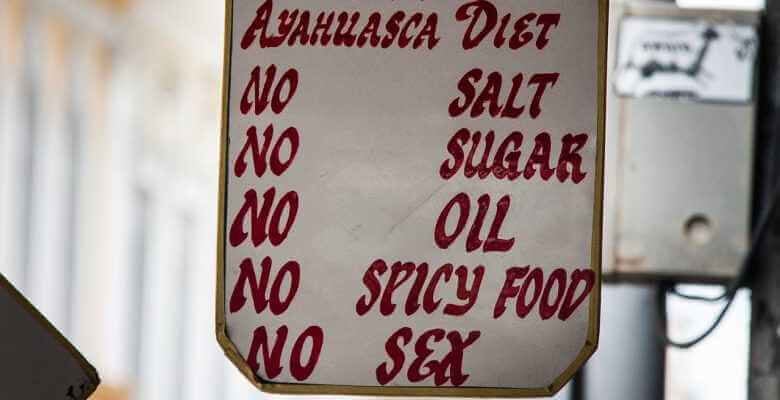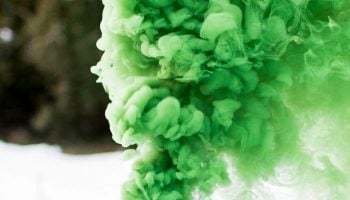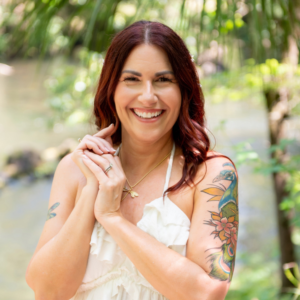What is an Ayahuasca Dieta?
An ayahuasca diet, or, how it’s commonly referred to in indigenous shamanic circles and retreat centers in the Amazon, la dieta, is a set of guidelines recommended to those interested in participating in an ayahuasca ceremony. Most notably, la dieta references the dietary restrictions revolving around ayahuasca use. But, aside from that, it’s a comprehensive collection of dos and don’ts that includes advice on psychological, social, and sexual aspects of one’s behavior before and after taking ayahuasca.
An ayahuasca diet is recommended by most individuals or organizations serving the brew in a ritualistic purpose. The larger, more established retreat centers include it in their email communication with people who book a retreat with them as mandatory instructions on how to prepare for it. The smaller family-owned centers and single shamans that you may run into while traveling in the Amazon will recommend it, but mostly leave it up to your judgment as to how strictly you want to follow it.
The reason why established ayahuasca service centers enforce the diet is because there are clear, factual benefits to it: cleansing the body and mind of matter and thoughts that are not serving it has a sort of a meditative effect, which can bring the participants into a balanced, peaceful state. This condition of psychophysical clarity is favorable for intention setting, an important part of the ayahuasca journey, which can be done more genuinely with less clutter and distractions. Following the diet after the experience can help integrate insight and make peace with the otherworldly content witnessed while under the effects.
The reason why smaller places are more relaxed about upholding a strict ayahuasca diet is because they don’t carry as much responsibility. Their prices are drastically lower, their clientele mostly travelers (more likely to have already had prior experience with ayahuasca), so they don’t feel like they necessarily need to tailor their service to meet Western expectations. Aside from this, for all the benefits an ayahuasca diet can bring, not maintaining one shouldn’t make the experience worse (aside from some dietary restrictions that can cause health complications if not followed; read on to learn more). Disregarding la dieta mostly results only in a more limited scope of vision and insight received from the journey.
If you’re interested in working with Ayahuasca, browse vetted and verified Ayahuasca retreat providers through Third Wave’s Directory.
How to diet before and after an Ayahuasca ceremony
Retreat centers have varied dieting guidelines, ranging from a few dietary and behavioral instructions to more than a hundred different foods and substances to avoid, and rigorous lists of thoughts and acts to abstain from.
Purifying the body
A common core and a modest minimum that most centers recommend is to avoid red meat, pork, sugar, spicy foods, coffee, alcohol (especially wine), illicit drugs, antidepressant medications, and sexual activities for a period of three days before and after drinking ayahuasca.
A more serious set of restrictions would see the discontinuation of alcohol and drugs (this includes various medications) at least two weeks prior to the ceremony, and the elimination of oily/fried food, fermented or aged foods, canned or packaged meat or fish products, protein or yeast-based extracts or supplements, dairy products (especially fermented ones), overripe fruits, processed sweets, and refined sugar, as well as excessive salt for at least three to five days before and after the ceremony.
Most of these foods are actually safe to ingest before drinking ayahuasca, and the benefits of abstaining from them are mostly in the healthier mindset that comes from the feeling of a happier body that’s not struggling to process difficult, heavy food. However, some restrictions have chemical reasoning behind them, specifically those concerning tyramine-rich foods. This compound can have a negative interaction with monoamine oxidase inhibitors (MAOIs), which are the main active ingredient of the ayahuasca vine Banisteriopsis caapi, and can potentially induce adverse reactions such as heart palpitations, nausea and headaches. Tyramine is found in fermented, cured, aged, or overripe foods, as well as soy products, pickled products, certain beans, sourdough bread, draught beer, and wine. These all should be categorically avoided.
A healthy ayahuasca diet plan: What’s advisable to eat are healthy and somewhat bland foods such as fresh fruits (and juices), fresh or cooked vegetables with rice, barley, oats, and other cereals, beans, peas, and other legumes, all with minimal levels of salt, sugar, and fat. Remember – if it’s not boring, you’re not doing it right!
On the day of the ceremony, you shouldn’t abstain from food; because your body will need energy to deal with the intense experience. Rather, eating raw fruits and vegetables is a good choice to load up on vitamins and nutrients.
Purifying the mind and spirit
Aside from the dietary constraints, an ayahuasca dieta involves a regimen of purification of thought and action. This means, first and foremost, trying to avoid stress, shocks, and other events that may cause disturbing and negative, or otherwise intense feelings. Most retreat centers advise abstaining from sexual relations, as they can cause big energetic shifts in your body, which are unfavorable for maintaining focus and balance needed for setting intentions, and may leave you vulnerable to others’ energies during the ceremony. Retreat centers often say that the spirit of ayahuasca can get jealous, and that avoiding sex mitigates this.
If possible, it’s a good idea to try to take a few days off from work, or at least to steer clear of tight deadlines, intense KPIs, painstaking meetings, and similar stressors. As far as social interaction goes, limiting contact with people who might be unsupportive about your plans, or instill anxiety and doubt with their fears or mockery is advised. The ayahuasca journey is a deeply intimate and personal one, and not everyone can understand it, so make sure to share it only with those whose support you can rely on.
Setting the intention: This ties in with the intention bit – before going into the ayahuasca experience, it’s useful to take some time to look inward and come up with one or a few things you’d like to get out of it. There’s a lot of buzz about this concept, and it’s normal to feel confused about what it should be and apprehensive about getting it wrong.
We’re here to tell you that you can’t really get it wrong. Intentions can be general or specific, they can be questions, requests or statements, they can be about the past, present, or future, they can be silly or serious, big or small, or anywhere in between any of these. The only thing that matters is that they come from within you and that they are meaningful to you. You will bring them with you on the journey and, if they are genuine, they will guide you toward what you’re supposed to learn and understand, and you’ll be able to use them as a lifeline if you drift away into something undesirable or simply distracting.
Some important questions you can ask yourself to arrive at your intentions:
What would I like to change about my life?
What brings me stress or burdens me?
What past issues have I not resolved?
What can I clarify about myself, my relationships, or my purpose?
Post-Ayahuasca dieting
Finally, after the ceremony or retreat has passed, you may feel like you’re off the hook in terms of holding up a regimen to cleanse your mind and body because ayahuasca and the shaman have just done it for you. Right?
Wrong.
Dieting after ayahuasca is an important and valuable means to integrate everything that happened during the ceremony. If you want to maintain the momentum of your healing, keep the insights you’ve gained, and have them apply in your life journey, it is recommended to seal that commitment with a little bit of post-sacrifice.
The recommended dieta from before the ceremony still applies, down to the letter. The times advised are even longer than prior to taking ayahuasca, but we know the motivation is lower when there is no clear goal in sight. So, we suggest aiming for a balance between respecting your integration process and being kind to your hedonistic desires. The longer you can make it, the better.
Indigenous roots of the Ayahuasca dieta
There is a belief among certain indigenous Amazon communities that the many pathologies that can occur with the body are caused by its temporary dissociation from the soul. This divergence is believed to have a root in the violation of food taboos. Food is something of a sacred matter to indigenous Amazonian peoples. Along withs plant medicine, it is the point of their communion with the jungle – it’s what the jungle shares with them, to keep them healthy and happy.
This gift is to be revered, and not abused. The food taken from the jungle is to be just enough for the needs of the community, not more (except for certain collective rituals and celebrations in which abundance is symbolic and complementary to the gathering’s purpose). It is also to be blessed by the shamans, to send off any potential evil energies and ensure wholesome consumption.
The shamans themselves go through a lengthy dieta during their training. They are known to spend years in the jungle fasting on what sources of nutrition they can find, and dieting the master plant ayahuasca and another plant whose powers they learn with the vine’s help.
With all this in mind, the ayahuasca diets that retreat centers prescribe are an important point of introduction of indigenous traditions to the Western visitors. So, aside from all the psychophysical benefits of the ayahuasca diet discussed in this text, there is the element of paying tribute to the ancestral indigenous ways as an additional reason to follow the recommendations; one that may well be the deciding factor of how ethereal your ayahuasca journey turns out. After all, the spirits of the jungle are more likely to make contact with a soul that shows them respect and a willingness to walk the path like the children of the jungle do.
We’ve written more about ayahuasca, and what to expect when you drink it, here.







Great article! I loooove ayuhuasca. Anyone interested in this stuff should definitely check out the book Everyday Roots. It teaches you how to replace all the toxic chemicals in your life with healthy organic alternatives. Its completely changed my life and how I feel everyday! 🙂
Heres a great review of everday roots: http://reggiesreview.weebly.com/everyday-roots-review.html
Keep up the great content!